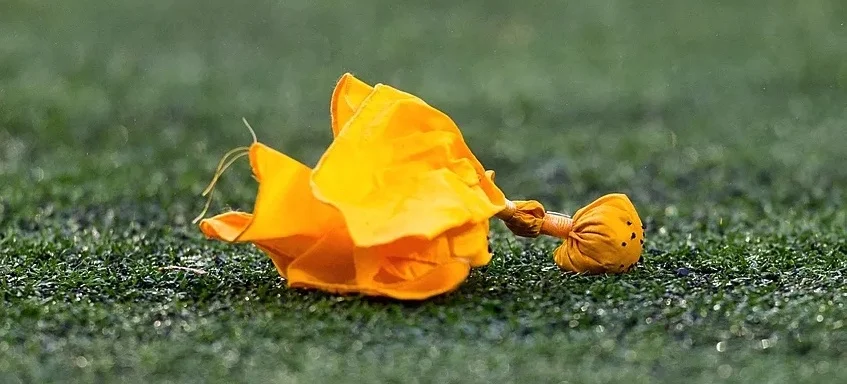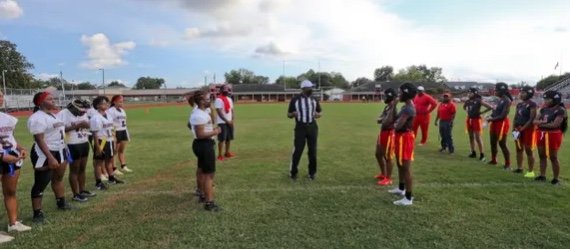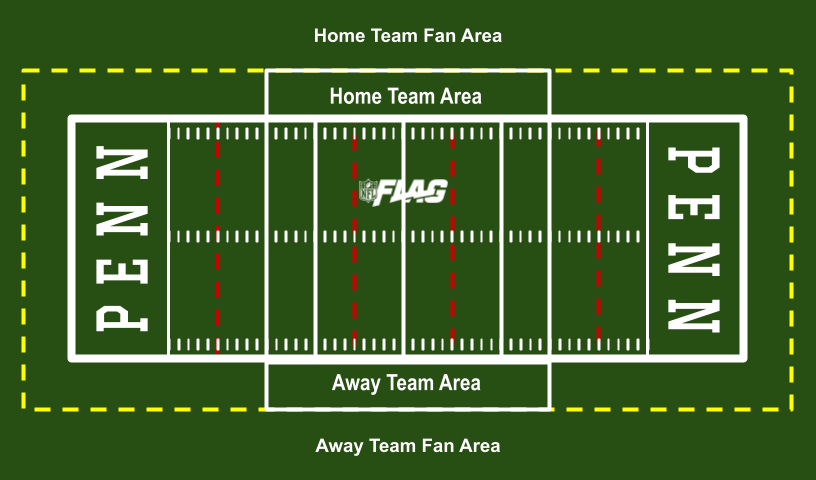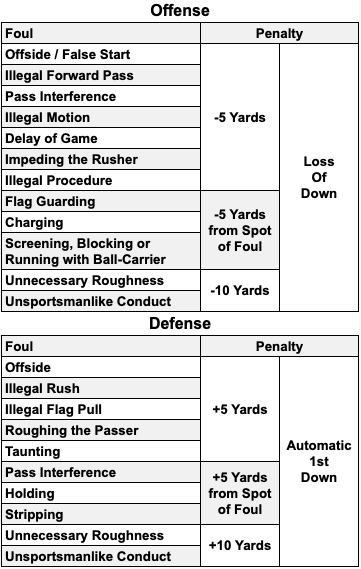Pre-Game
Teams and coaches from both teams meet at midfield for the Uniform and Equipment Check, followed by The Coin Toss.
Uniform and Equipment Check
Home Team is wearing dark jerseys.
Away Team is wearing white jerseys.
Players must have a mouthguard.
Jerseys are tucked in.
Players are wearing black pocketless shorts.
Flags are on the hips, free from obstruction, pointed down and outward.
No excess belt length hanging like a flag. How to shorten your belt.
No metal cleats.
No jewelry.
No hats. Winter caps are allowed.
The Coin Toss
The Away Team Captain chooses heads or tails.
The winner of the coin toss chooses offense or defense.
The loser of the coin toss chooses direction.
The Field
The Field is 64 or 70 yards long by 25 yards wide.
There are two 7 to 10 yard end zones and a midfield line.
5-yard no-run zones precede the midfield line and the end zone.
Stepping on the boundary line is considered out of bounds.
Coaches and players remain in their Team Zone.
Fans remain in their Fan Zone.
Timing and Clocks
The game clock is 48 minutes, with two 24 minute halves.
The game clock stops for halftime, timeouts, injuries, ejections, and referee’s discretion.
Halftime is 2 minutes.
A 40-second play clock starts when the ball is spotted.
A 7-second pass clock starts when the ball is snapped.
Each team has one 60-second timeout per half. They do not carry over.
If the score is tied at the end of regulation time, Overtime will determine a winner.
Scoring
A touchdown is 6 points.
A team that scores a touchdown will attempt either a 1-point conversion from the 5-yard line or a 2-point conversion from the 10-yard line.
Once a decision is made, any change would require a timeout.
A decision cannot be changed after a penalty.
An interception returned for a touchdown is 6 points.
An interception returned for a touchdown during a conversion is 2 points.
A safety is 2 points.
After one team is winning by 35 points or more, the game is technically over and the score at that time stands. However, the game will continue as a scrimmage to full time.
Forfeits are scored 35-0 for the winning team.
The Game
The offensive team takes possession of the ball on its own 5-yard line and has 4 downs to cross midfield.
Once a team crosses midfield, it has 3 downs to score a touchdown.
If the offensive team fails to cross midfield on 3 downs, and elect to "Punt" on 4th down, possession of the ball changes, and the opposition starts its drive from its own 5-yard line.
If the offensive team goes for it on 4th down and does not cross midfield, the opposing team will start its possession from the spot.
Offensive team must declare 4th down intent of “Play or Punt” when asked by the referee and prior to the “Ready for Play.”
Teams may use a timeout only to change the declaration of “Play” at any time prior to the expiration of the play clock.
If the declaration is “Punt” the ball changes possession and will be placed at the opposing team’s 5-yard line, 1st down, with no option to change the declaration.
If the offense fails to score after crossing midfield, the ball changes possession and the new offensive team starts at its 5-yard line.
Teams change sides after the first half and possession changes to the team that started the game on defense.
Overtime
Captains from both teams meet at midfield for the overtime Coin Toss.
The Home Team Captain chooses heads or tails.
The winner of the coin toss chooses offense or defense.
The referee will determine which end of the field the overtime will take place.
The final score includes all overtime points scored for each team.
Teams take turns attempting a 1 or 2 point conversion until there is a winner.
Coaches
Coaches must adhere to the Coaches Code of Conduct.
Coaches are responsible for their own behavior as well as that of their players, parents, and fans.
Coaches are permitted to Coach on the sideline.
Coaches must remain in their Team Area and are not allowed on the field of play during the game, unless permission is given by the referee.
In 2nd Grade and younger leagues, one Coach for each team is permitted on the field to help their players.
No more than 3 coaches are permitted in the Team Area.
Offense
Live Ball / Dead Ball
The ball is live at the snap of the ball and remains live until the official whistles the ball dead.
Substitutions may be made on any dead ball.
A fumble is an immediate dead ball, which is spotted where the ball-carrier lost possession.
Play is ruled dead when:
The ball hits the ground. If the ball hits the ground as a result of a bad snap, the ball is spotted where the ball hit the ground.
The ball-carrier’s flag is pulled.
The ball-carrier’s flag falls out.
The ball-carrier steps out of bounds.
The ball-carrier’s knee or arm hits the ground.
The ball-carrier leaves their feet other than jump cuts, spinning or to avoid a downed player on the field of play.
A touchdown, extra point or safety is scored.
The receiver catches the ball while in possession of one or no flag(s).
The game clock expires.
The play clock expires.
The pass clock expires.
There’s an Inadvertent whistle
Formations
The referee will use orange discs to mark the line of scrimmage, the 1-yard neutral zone, and the 7-yard rush line.
Offside is a dead ball foul when any player on defense or offense enters the neutral zone.
Offense must have a minimum of one player on the line of scrimmage, the center, and up to four players on the line of scrimmage. The quarterback must be off the line of scrimmage.
The quarterback is the offensive player who receives the snap from the center.
Offense must be set for at least 1 second before the ball is snapped.
One player at a time may be in motion at least 1 yard behind the line of scrimmage.
Movement by a player who is set, or a player who runs toward the line of scrimmage while in motion, is considered a false start.
The center must snap the ball with a rapid and continuous motion between their legs to a player in the backfield, and the ball must completely leave their hands.
In 2nd Grade and younger leagues, side snaps are permitted.
In Pre-Kindergarten and Kindergarten, it’s coach snap, where a coach takes a knee and side snaps the football.
Running
Teams may not advance the ball beyond the line of scrimmage with a running play if the line of scrimmage is in a no-run zone.
In 2nd Grade and younger leagues, the no-run zones are eliminated.
Ball-carriers must make an effort to avoid defenders with an established position.
The quarterback cannot directly run with the ball.
Blocking or screening is not allowed.
Running with the ball-carrier is not allowed. Offensive players in close proximity to the ball-carrier must stop their motion once the ball has crossed the line of scrimmage.
Pitches, laterals, and backwards passes are permitted behind the line of scrimmage only.
Handoffs must be behind the line of scrimmage.
The quarterback is not allowed to handoff to the center on the first handoff of the play.
Once the ball has been handed off, the 7-second pass clock is eliminated and all defensive players are eligible to rush.
A player who receives a handoff can throw the ball from behind the line of scrimmage.
Runners may not leave their feet to advance the ball.
Diving, leaping or jumping to avoid a flag pull is considered flag guarding.
Spinning/Jump Cuts are allowed, but players cannot leave their feet to avoid a flag pull.
Players spinning out of control will be called for flag guarding.
Ball-carriers may leave their feet and the play will continue for spinning, jump cuts, quarterbacks passing progression or if there is a clear indication that he/she has done so to avoid a collision with another player and the play will continue without stoppage.
Passing
All passes must be thrown with one hand from behind the line of scrimmage, thrown forward and ball out of hand prior to breaching the line of scrimmage.
All passes that do not cross the line of scrimmage, whether received or not, are illegal forward passes, unless touched by a defender.
The quarterback may throw the ball away to avoid a sack. The pass must go beyond the line of scrimmage.
Shovel passes are allowed, but must be received beyond the line of scrimmage.
The quarterback has a 7-second pass clock. If a pass is not thrown within seven seconds, the play is dead, the down is consumed, and the ball is returned to the line of scrimmage, even if the quarterback is in their own end zone.
Once the ball is handed off, the 7-second pass clock is no longer in effect.
If the quarterback throws the ball and then catches it, the play is dead and treated like an incomplete pass.
Receiving
All players are eligible to receive a pass, including the quarterback if the ball has been handed off.
For a reception to be legal, a player must have at least one foot or other body part in bounds, contacting the ground first, with possession.
In the case of simultaneous possession by both an offensive and defensive player, possession is awarded to the offense.
Defense
Rushing the Quarterback
The referee will mark a rush line with an orange disc seven yards from the line of scrimmage.
All players who rush the quarterback must be behind the rush line when the ball is snapped.
Up to two players can rush the quarterback.
Rushers must identify themselves by raising their hand before the snap.
Rushers must rush the passer immediately after the snap.
Players not rushing the quarterback can defend on the line of scrimmage.
A sack occurs if the quarterback’s flags are pulled behind the line of scrimmage.
A safety is awarded if a sack takes place in the end zone of the team on offense.
Once the ball has been handed off, the rush line is no longer in effect and all defensive players may go behind the line of scrimmage.
In 2nd Grade and younger leagues, Defenders may not rush the passer unless there is a legal handoff in the backfield.
The offense cannot impede the rusher in any way. The rusher has the right to a clear path to the quarterback, regardless of where they line up prior to the snap. The path is set pre-snap from the rusher or rushers directly to the quarterback. The path does not move once the quarterback moves. If the path is occupied by a moving offensive player, then it is the offense’s responsibility to avoid the rusher. Any disruption to the rusher’s path and/or contact will result in an impeding the rusher penalty. If the offensive player does not move after the snap, then it is the rusher’s responsibility to go around the offensive player and to avoid contact.
Flag Pulling
A legal flag pull takes place when the ball-carrier is in full possession of the ball.
The ball is spotted where the ball is when the flag is pulled.
Defenders are allowed to dive to pull flags.
Defenders are not allowed to tackle or run through the ball-carrier when pulling flags.
It is illegal to attempt to strip or pull the ball from the ball-carrier’s possession at any time.
If a player's flag inadvertently falls off during a play while that player has possession, the player is down immediately and the play ends. The ball is placed where the flag lands.
If a player, who has one or no flags in their belt, takes possession of the ball, the play is dead at that spot on the field.
A defensive player may not intentionally pull the flags off of a player who is not in possession of the ball.
Flag guarding is an attempt by the ball-carrier to obstruct the defender’s access to the flags by stiff arming, dropping the head, hand, ball, arm or shoulder or intentionally covering the flags with the football jersey.
Unsportsmanlike Conduct
If the referee witnesses any acts of intentional tackling, throwing a punch, or a forearm, or kicking at an opponent, even though no contact is made, the game will be stopped and the player will be ejected from the game. The decision is made at the referee’s discretion. No appeals will be considered.
Using abusive, threatening, or offensive language or gestures to opponents, teammates, officials, or anyone, is not allowed. Officials will determine if a warning or immediate ejection is warranted.
The defense may not mimic the offensive team signals by trying to confuse the offensive players, while the quarterback is calling out signals to start the play. This will result in an unsportsmanlike conduct penalty.
No one in attendance may physically or verbally abuse anyone else. Offending players or coaches will be ejected from the game. Offending individuals must leave the premises. The game will remain suspended until offending individuals have left the premises.
Fouls and Penalties
All jerseys must be tucked in before play begins.
The flags must be on the player’s hips and free from obstruction.
Deliberately obstructed flags will be considered flag guarding.
If an inadvertent whistle occurs, the offense has two options:
A) take the ball where the whistle blew and the down is consumed
B) replay the down from the original line of scrimmage.
If it occurs on the last play of the half or game, the offense will be awarded one untimed down and given those two options.
A team is allowed to use a timeout to question a referee’s rule interpretation. If the referee’s ruling is correct, the team will be charged a timeout. If the rule is interpreted incorrectly, the timeout will not be charged and the proper ruling will be enforced. Referees should all agree in order to change a call on the field that is in dispute.
Referees determine incidental contact that may result from normal run of play.
Penalties are assessed from the line of scrimmage, except Spot Fouls, which are assessed from the spot on the field where the foul occurred.
Only the team captain or head coach may ask the referee questions about rule clarification and interpretations.
Games or halves may not end on a defensive penalty unless the offense declines it.
Penalties are assessed live ball, then dead ball. Live ball penalties must be assessed before play is considered complete.
Penalties will be assessed half the distance to the end zone yardage when the penalty yardage is more than half the distance to the end zone.
Defensive Spot Fouls in the end zone result in the ball on the one-yard line and a first down.
Offensive Spot Fouls in the end zone result in a Safety.







